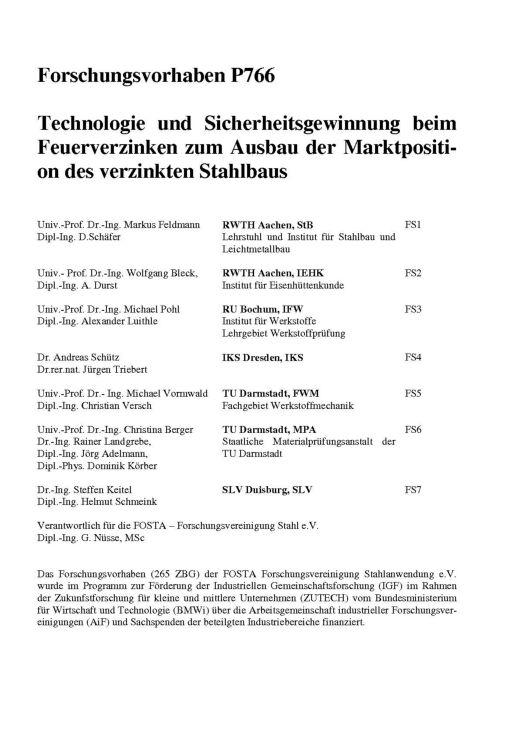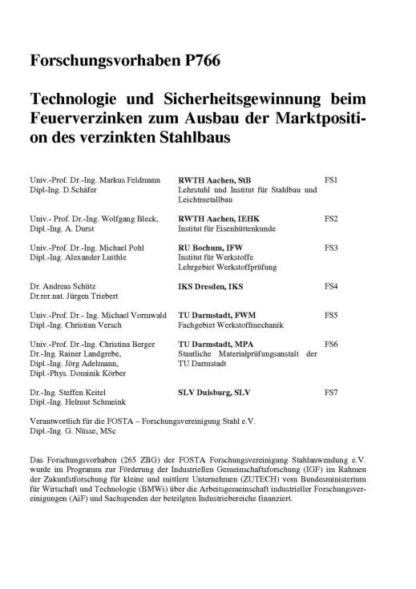Description
P 766 – Examination of Hot Dip Galvanizing of welded steel products with respect to safe construction and development of market position in the steel construction market
Hot Dip galvanizing allows designing and building steel structures in a very economic and sustainable way. To encounter the increasing challenges in industry market the participating industries steel making, steel construction and hot dip galvanizing have improved the process technology and the economical application. These improvements in detail were:
– Development of modern high strength steels both as
plate and profile,
– Realization of design for architectural exceptional
buildings with large spans,
– Application of larger galvanizing vessels and quality
chain improvements of the full process of hot dip galvanizing,
– Use of newly developed zinc alloys which allowed
better control of coating thickness and appearance.
Subsequently to these developments major technological draw backs had to be faced by industry since 2000 in form of an increasing amount of cracks found in welded constructions made from modern steels which were galvanised in the new type of zinc bath composition. Investigations showed that such cracks were a result of the known mechanism of Liquid Metal Embrittlement (LME). Although the crack initiation resulting from LME is known since decades in the technical world, the new problems could not alone be explained by the existing knowledge. Therefore it was found necessary to initiate a new research attempt with an interdisciplinary approach to answer open question and to provide solutions and new developments for the involved industries. Beside that it was found that no guidelines exist so far which would allow the industry partners to design and build hot dip galvanised and crack free steel constructions. Before this background this research project has been initiated.
The main focus was on the following aspects: influence from pickling, influence of the material (strength, toughness), from fabrication (welding, cutting, drilling, cold forming), from zinc bath composition and dipping speed. Furthermore optimised openings in hollow sections were investigated.
The results achieved support parallel running initiatives of drafting a new guideline from the “Deutscher Ausschuß für Stahlbau DASt” and from the Association of German Engineers (VDI) for crack free hot dip galvanising of steel constructions. In detail they enable the improving of laboratory tests for the derivation of criticality of zinc alloys, the creation of physical input values for numerical simulation of hot dip galvanizing and the development of new metallographic preparation methods. For constructions where cracks from hot dip galvanizing cannot be excluded the magnetic powder test technology has been extended beyond existing limitations.
The research project (IGF-Nr. 265 ZBG) has been carried out at RWTH Aachen, Lehrstuhl und Institut für Stahlbau und Leichtmetallbau and Institut für Eisenhüttenkunde, at Ruhr- Universität Bochum, Institut für Werkstoffe, Lehrgebiet Werkstoffprüfung, at Institut für Korrosionsschutz Dresden GmbH, at Technischen Universität Darmstadt, Institut für Stahlbau und Werkstofftechnik, Fachgebiet Werkstoffmechanik, at Staatliche Materialprüfungsanstalt Darmstadt, Fachgebiet and Institut für Werkstoffkunde and at Schweißtechnischen Lehr- und Versuchsanstalt Duisburg GmbH. FOSTA has accompanied the research project work and has organized the project funding from the Federal Ministry of Economics and Energy through the AiF as part of the programme for promoting industrial cooperation research (IGF) in accordance with a resolution of the German parliament.
Only available in german language.
Authors:
M. Feldmann, D. Schäfer, W. Bleck, A. Durst, M. Pohl, A. Luithle, A. Schütz, J. Triebert, M. Vormwald, C. Versch, C. Berger, R. Landgrebe, J. Adelmann, D. Körber, S. Keitel, H. Schmeink
Published in:
2010




